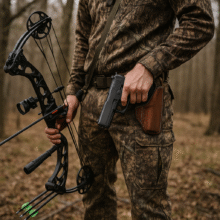Mastering the Basics: How to Read a Compass

Table of Contents
- Introduction
- 1. Understanding Compass Components
- 2. Setting a Bearing
- 3. Taking a Bearing from a Map
- 4. Correcting for Magnetic Declination
- 5. Tips for Accurate Compass Use
- 6. Navigating Without a Map
- 7. Advanced Techniques
- 8. Compass Care and Maintenance
- 9. Choosing the Right Compass
- 10. Teaching Others Compass Skills
- Conclusion
- Frequently Asked Questions (FAQs)
Introduction
Understanding how to read a compass is a fundamental skill for navigation, particularly when hiking or engaging in outdoor activities where GPS may not be available. A compass points you toward magnetic north and helps you determine your direction relative to the Earth’s magnetic poles. This guide will walk you through the basic steps of reading a compass effectively.
1. Understanding Compass Components
1.1 Magnetic Needle
- Color-Coded: Typically, the compass needle is color-coded, with the red end pointing towards magnetic north. Remember, the needle points to magnetic north, not true north (geographic north).
1.2 Baseplate
- Clear Base: The baseplate is usually transparent and contains a ruler for map measurements. It should be held level to accurately read the compass.
1.3 Rotating Bezel (Azimuth Ring)
- Degrees: The bezel rotates and is marked with degrees from 0 to 360. This is used to set and read your bearing.
1.4 Orienting Arrow and Lines
- Alignment Features: Inside the compass housing, you’ll find the orienting arrow and orienting lines, which are used to help align the compass correctly with a map.
2. Setting a Bearing
2.1 Align the Bezel
- Setting Course: To set a bearing, turn the bezel so the desired degree on the bezel lines up with the direction of travel arrow on the baseplate.
2.2 Read the Bearing
- Determine Direction: Holding the compass flat, turn your body until the red end of the magnetic needle lines up with the orienting arrow of the compass housing. The number on the bezel that aligns with the direction of travel arrow now indicates your bearing.
3. Taking a Bearing from a Map
3.1 Place the Compass on the Map
- Align with Map Lines: Place your compass on the map so the edge of the baseplate connects your current location with your desired destination.
3.2 Rotate the Bezel
- Align North: Rotate the bezel until the orienting lines and the orienting arrow line up with the map’s north-south grid lines. Make sure the compass’s direction of travel arrow points towards your destination.
3.3 Translate to the Ground
- Transfer Bearing: Pick up the compass and turn your body until the red end of the magnetic needle aligns with the orienting arrow. The direction of travel arrow now points to your destination in the real world.
4. Correcting for Magnetic Declination
4.1 Understand Declination
- Adjust for Variation: Magnetic declination is the angle between magnetic north and true north. It varies depending on where you are on Earth. Most maps provide information on local declination.
4.2 Adjust the Compass
- Apply Declination: If your compass has a declination scale, use it to adjust the bezel accordingly. If not, you’ll need to mentally adjust the bearing you follow by the declination amount.
5. Tips for Accurate Compass Use
5.1 Keep Away from Metal and Electronics
- Avoid Interference: Metal objects and electronic devices can interfere with the compass needle. Ensure there are no potential sources of interference near your compass when taking bearings.
5.2 Regularly Practice
- Skill Maintenance: Regular practice with your compass will help you gain confidence and speed in navigation, making it a reliable tool for any adventure.
6.1 Using Landmarks
- Landmark Navigation: When you don’t have a map, use your compass in conjunction with natural landmarks or features. Determine the bearing to a noticeable landmark and navigate towards it, resetting your bearing as you reach each landmark.
6.2 Path Correction
- Stay on Track: Regularly check your compass to ensure you’re staying on the intended bearing. This is especially important in dense forests or foggy conditions where visible landmarks might be obscured.
7. Advanced Techniques
7.1 Triangulation
- Location Pinpointing: If you’re unsure of your location, use the triangulation method. Take bearings from your position to three known locations visible on your map and on the landscape. Draw lines along these bearings from the known locations on your map; the point where they intersect is your location.
7.2 Back Bearings
- Reverse Navigation: To return to your starting point or ensure you can find your way back, take a back bearing. This is the opposite direction of your original bearing and can be calculated by adding or subtracting 180 degrees from your original bearing.
8. Compass Care and Maintenance
8.1 Routine Checks
- Compass Health: Regularly inspect your compass for damage, such as a cracked housing or air bubbles in the liquid-filled chamber, which can affect accuracy.
8.2 Cleaning and Storage
- Proper Handling: Clean your compass with a soft cloth and store it in a dry, cool place away from direct sunlight and strong magnetic fields to maintain its accuracy and prolong its lifespan.
9. Choosing the Right Compass
9.1 Types of Compasses
- Selecting Based on Use: Consider the specific needs of your outdoor activities when choosing a compass. For hiking, a baseplate compass is generally sufficient, while more technical pursuits like orienteering or marine navigation might require a precision or a prismatic compass.
9.2 Features to Consider
- Compass Features: Look for features like a global needle, which is effective across both hemispheres, luminous markings for low-light conditions, and built-in declination adjustment for convenience.
10. Teaching Others Compass Skills
10.1 Educational Workshops
- Community Learning: Organize or participate in workshops to teach others how to use a compass. Sharing your knowledge can help prepare more people for safe outdoor adventures.
10.2 Creating Guides and Resources
- Resource Development: Develop online resources, guides, or video tutorials that can help others learn about compass use. This can be particularly useful for educators, guides, and outdoor enthusiasts.
Conclusion
A compass is a vital tool for navigation that doesn’t rely on batteries or satellite signals, making it exceptionally reliable when you’re off the beaten path. By learning how to read and use a compass properly, you enhance your outdoor skills and prepare yourself for safe exploration in any environment.
Frequently Asked Questions (FAQs)
How often should I replace my compass?
- Compass Lifespan: A good quality compass can last many years if properly cared for. Regular checks for air bubbles in the liquid housing and demagnetization of the needle are essential.
- Compass Types: While basic compass skills are transferable, different types of compasses may be better suited for specific activities. For example, a mirror sighting compass is often used for precise directional readings in wilderness navigation.
What should I do if my compass seems to be giving incorrect readings?
- Troubleshooting: First, ensure you’re not near any magnetic sources that could interfere with the needle. If the problem persists, consider having your compass professionally calibrated or replaced if it’s old or damaged.
Is it necessary to know how to use a compass in the age of GPS technology?
- Skill Relevance: Yes, compass skills remain relevant. Electronics can fail due to battery depletion, damage, or signal loss, especially in remote areas. A compass is a reliable, fail-safe navigation tool that works independently of electronic signals.







